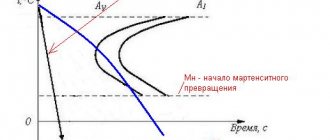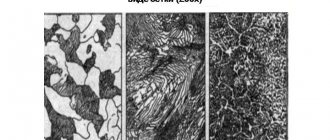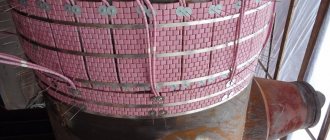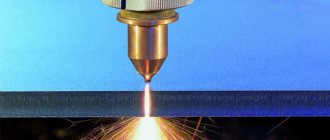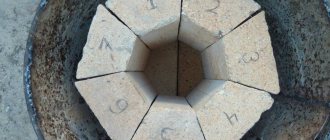Defects in hardened steel
The following defects may occur during hardening:
Insufficient hardness of the hardened product
This type of defect may appear as a result of an incorrectly selected quenching temperature or insufficiently intensive cooling.
For example, when quenching hypoeutectoid steels, insufficient hardness may result from the fact that the quenching temperature was lower than A C3
and ferrite remains in the steel structure.
In addition, in hypoeutectoid steel, reduced hardness may be a result of overheating. In this case, the formation of a coarse-needle martensite structure, in addition to reduced hardness, causes a decrease in impact toughness.
In hypereutectoid steels, insufficient hardness of the hardened product can also be the result of overheating and the formation of coarse-needle martensite.
Overheat
and
underheating
are corrected by repeated hardening. Sometimes, before re-hardening, parts of complex shapes are annealed to eliminate internal stresses.
Formation of soft spots
This type of defect may be the result of uneven cooling, contact of parts with each other during the cooling process, the presence of grease stains on the surface of the product and heterogeneity of the structure (ferrite accumulation).
It can be corrected by repeated hardening. The heterogeneity of the structure is eliminated by preliminary normalization.
Oxidation and decarbonization
Oxidation and decarbonization
characterized by the formation of scale (oxides) on the surface of products and burnout of carbon in the surface layers
(decarbonization).
This type of defect cannot be corrected by heat treatment.
If the machining allowance allows, the oxidized and decarbonized layer is removed by grinding.
To prevent this type of defect, it is recommended that products be heated in furnaces with a neutral atmosphere or in liquid media.
Burnout
Burnout phenomenon
occurs at very high heating temperatures, close to the melting point.
In this case, oxygen penetrates into the metal and the formation of oxides located along the grain boundaries, or even melting of the metal along the grain boundaries, which violates the continuity of the metal, and the metal becomes unsuitable for use.
Hardening cracks
Hardening cracks
may be the result of too rapid and uneven heating, or too
rapid cooling,
or the presence of sharp cross-sectional transitions on the part, where large internal stresses arise, leading to cracking of the product.
Quenching cracks can also occur if, after quenching, the part is not immediately tempered to relieve internal stresses (this is especially important for carbon tool steels).
To eliminate cracking of parts during hardening, it is necessary to ensure uniform and slower heating (introduce preheating of the part), use hardening with cooling, in two environments or stepwise, temper the products immediately after hardening, etc.
Deformation and warping
Deformation and warping,
those. changes in the dimensions of the product and distortion of its shape occur due to the fact that the structures have different specific volumes.
This should be taken into account when assigning grinding tolerances. Specific volume of martensite
greater than the specific volume of perlite.
Source
Purpose of normalization
The normalization process is designed to change the microstructure of the metal. As a result of its implementation:
- the level of internal stress decreases;
- thanks to recrystallization, the coarse-grained structure is refined
- intermediate blanks obtained by plastic deformation - forgings;
- products made by pouring molten metal into special molds - castings;
- section of the welding joint, called the “weld”.
The use of normalization provides an opportunity to realize completely different, sometimes even opposite, goals. In particular, you can either increase or decrease the hardness of steel. This extends to the strength characteristics of the final product, as well as its impact strength. Everything is determined by the thermal and mechanical properties of the alloy.
In castings that have undergone the normalization procedure, a homogenized structure is formed, the level of susceptibility to thermal hardening increases and residual stresses decrease. The purpose of applying this technology to products produced by pressure treatment is to reduce the banding of the structure and its different grain sizes.
Normalization together with tempering replaces hardening of workpieces characterized by a complex configuration and having sharp transitions in the cross-section. This technological solution prevents the formation of areas with defects.
It is worth mentioning other areas of application of this type of heat treatment. It is carried out for:
- improving the structure of the metal before undergoing the hardening procedure;
- increasing machinability by cutting operations;
- eliminating the network of secondary cementite in the hypereutectide alloy;
- preparing the metal for the final stage of heat treatment.
Defects that occur during hardening of steel
Incorrectly carried out hardening causes a number of defects in the metal. These primarily include insufficient hardness, soft spots, increased brittleness, deformation, warping and cracks.
Insufficient hardness may be a consequence of a low heating temperature of the metal before hardening for hypoeutectoid steel grades; insufficient holding of the metal at the hardening temperature; low cooling rate during hardening; overheating of the metal before hardening for hypereutectoid steel grades.
Types of heat treatment of steels
Depending on the nature of the thermal effect on the metal and the methods of introducing additional energy into its structure, the following main types of heat treatment are distinguished:
- Annealing is used to improve the subsequent deformation of workpieces and provides them with an equilibrium fine-grained structure. In turn, annealing can be high- and low-temperature.
- Hardening – gives parts increased hardness and mechanical strength. It is performed in electric or flame heating devices and is divided into surface and volumetric.
- Tempering is usually performed after hardening and ensures a gradual decrease in the strength of steel as it moves away from the surface. As a result, thermal stresses that lead to warping of parts are relieved.
- Normalization - consists of correcting the unfavorable structure of steel and improving its subsequent machinability.
- Improvement - is carried out to give steel parts an optimal combination of strength and toughness, which is essential if the product operates under significant dynamic loads.
Less common, but also used: aging (stabilization of the structure of heat-treated steel), cold treatment (provides parts with increased accuracy), as well as combined processes that combine heat treatment with deformation of the steel, saturation of its surface with other elements, and so on.
Possible defects when hardening steel
Incorrectly carried out hardening can cause various defects. The most common of these are: insufficient hardness, soft spots, increased brittleness, decarburization and oxidation of the surface and, finally, warping, deformation and cracks.
Deformation, warping and cracks are a consequence of internal stresses, the cause of which we discussed earlier.
Slow cooling during quenching in the region of martensitic transformation is the most effective way to reduce stress and eliminate defects of this type.
Rice. 244. Correct (a) and incorrect (b) design of parts
Small parts, as well as those that are simple in shape, without sharp corners and sharp transitions, are less prone to warping. Therefore, during design, giving a part a technological shape is an important way to reduce this type of defect. In Fig. 244 provides examples of correct and incorrect design of parts. It is advisable to make parts with more complex shapes from alloy steels that can be hardened in oil rather than from carbon steels that can be hardened in water.
Insufficient hardness of the hardened part may be due to underheating (low temperature in the furnace, insufficient holding at the correct temperature in the furnace) or insufficient cooling. In the first case, martensite does not have sufficient hardness (does not contain enough carbon); in the second, it is not supercooled to the point of martensitic transformation, and the structure consists entirely or partially of the products of pearlite decomposition of austenite (trostite, sorbitol).
Deformation and warping
And the last possible defect of hardened steel is deformation and warping..
Structural changes that occur in the metal during heat treatment cause a change in volume (deformation), and uneven cooling causes a distortion of the external shape (warping).
Such defects in hardened steel occur due to the fact that the structures have different specific volumes. This should be taken into account when assigning grinding tolerances. For example, the specific volume of martensite is greater than the specific volume of pearlite. Also, the shape of various parts under the influence of structural stresses changes differently than under the influence of thermal stresses.
Bodies of simple shape after deformation and the correct position of the parts when immersed in the quenching tank
To prevent deformation and warping, it is necessary to ensure slow cooling in the martensitic transformation range by stepwise and isothermal hardening and hardening.
Ways to fix a marriage
In addition to the main defects, each type of heat treatment is also characterized by local ones. In many cases they are removable. Typical defects in heat treatment of steel can be reduced to the following:
- Inconsistency in the hardness of the processed product. Occurs when the specified mode is violated: for example, with an increased/decreased cooling rate, insufficient holding time of the workpiece in the oven, or as a result of heating to lower/higher temperatures. Corrected by repeated heat treatment;
- The appearance of a network of carbide inclusions. It is caused by overheating of the steel and is eliminated by normalizing the metal, or by repeatedly reforging the workpiece;
- Crack formation caused by cracking of a steel billet due to the high thermal stresses that arise in it during the martensitic transformation. The steel becomes brittle, the fracture has a pronounced coarse-grained character. It appears when the permissible cooling rates of the metal during hardening are exceeded. It is impossible to fix such a marriage;
- Decarburization: burning out of cementite in the surface layers of steel with the simultaneous formation of high-temperature iron oxide FeO. Occurs when the heated workpiece is kept in the oven for too long, or when using flame heating devices with an uncontrolled atmosphere. The defect can only be partially corrected: the workpieces can be normalized, but the grade of steel will change in the direction of reducing the percentage of carbon. Heating should be carried out in electric furnaces or in non-oxidizing heating furnaces;
- Uneven hardness over the surface or cross-section. The defect is associated with poor-quality tempering (for example, the use of a cooling medium contaminated with inclusions or the workpieces touching each other in the tempering container). The defect is eliminated by subsequent normalization and hardening using a more intense cooling medium, in particular water or an aqueous solution of NaCl;
- Mechanical deformation or warping of heat-treated products. They can be eliminated by straightening them on hydraulic presses, and, if necessary, by using repeated heat treatment, but with a slower cooling rate.
Defects that arise during heat treatment of joints of welded structures are eliminated by reheating them and subsequent cooling in still air.
Heat treatment services should be ordered from enterprises with a high production culture, modern equipment, effective instrumentation and control equipment, as well as qualified personnel.
